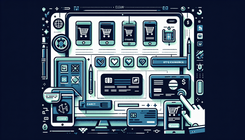Introduction
Author by BemeApps AI
E-commerce store owners using Shopify are often enthusiastic about creating the perfect user experience for their customers. Design consistency and ease of checkout influence a store's trustworthiness — a seamless flow, from browsing to final purchase, can impact conversion rates significantly.
One of the frequently encountered design issues in some Shopify themes is related to how the payment buttons (for example, PayPal, Google Pay, Apple Pay, and other accelerated checkout methods) appear on the cart page. In the Studio theme, specifically, a commonly cited concern is that these payment icons are not centered or not sized in a way that matches the regular checkout button.
In this comprehensive guide, we’ll delve into what causes this alignment discrepancy, why it matters for your shoppers, and how you can solve it using various methods. Additionally, we'll explore a broader perspective on common design alignment pitfalls, how different code modifications can help, and a few best practices on how to properly test or roll back changes when you encounter unexpected design issues.
This post goes well beyond a quick fix. We'll cover the potential reasons behind misalignment, as well as debugging tips for future reference. By the end of this guide, you’ll have a deep understanding of how to customize your Shopify Studio theme cart page, ensuring payment icons align properly and present a professional look to your customers.
Table of Contents
- Understanding the Alignment Problem
- Possible Causes of Misalignment
- Why a Consistent Layout Matters
- Step-by-Step Fixes
- Code Method in the
theme.liquidFile - Code Method in the
base.cssor Custom CSS - Tweaking with Media Queries
- Code Method in the
- Common Mistakes to Avoid
- Testing and Verifying Changes
- Additional Tips for Shopify Store Customization
- Frequently Asked Questions
- Related Posts
- Final Thoughts
1. Understanding the Alignment Problem
If you’ve seen payment methods such as PayPal or Google Pay below the main checkout button on your cart page — but they appear slightly off-center or smaller in comparison — you’re not alone. In the Studio theme, or any theme that emphasizes minimalistic design, these icons act a bit differently because they can be dynamically generated. They are separate elements, sometimes added via JavaScript or iframes, making them behave differently from the standard checkout button.
When these buttons or icons do not share the same styling or sizing properties, they look out of line. For instance, you might see the main checkout button at the left edge, with the PayPal and Google Pay icons not quite matching up, potentially floating to the right, smaller or misaligned. On mobile, it may look correct, but on desktop, things get out of balance.
This discrepancy can arise from how the theme's code manages elements on different screen sizes. Moreover, some CSS styles might override or conflict with each other, especially if multiple sets of rules are controlling the layout.
2. Possible Causes of Misalignment
A. Theme-Specific CSS Rules
Each Shopify theme, including Studio, may have unique class names and default styles for the cart page. Because accelerated payment buttons do not always follow the same code path as the standard checkout button, your theme might not automatically adjust them.
B. Dynamic Button Generation
Payment icons like PayPal, Google Pay, or Shop Pay might be injected after the main cart page loads. As a result, they can appear with default styling that might differ from your theme's styles unless you specify your own CSS rules.
C. Overriding Styles from Previous Code
If you have customized your theme in the past, sometimes certain rules remain in place, causing new styles not to work. A high specificity CSS rule or !important directive can override your current changes.
D. Sizing and Margins
Different payment buttons could have different default widths, margins, or internal padding. If these styles are not uniform or if the containers are not set to align properly, they can look misaligned.
E. Media Query Inconsistencies
Media queries can adjust how elements look on desktop vs. mobile. If the theme has styling that primarily focuses on mobile-friendly design, the desktop experience can be overlooked, leading to misalignment.
3. Why a Consistent Layout Matters
A. Professional Appearance
First impressions can be crucial. When crucial checkout buttons appear messy, potential customers may wonder whether your store is truly trustworthy.
B. Better User Experience
Consistency lowers frustration. If everything lines up neatly, customers can quickly scan their options and feel confident proceeding with their purchase.
C. Accessibility
Clear alignment can help individuals who rely on assistive technologies to understand where each button is located. A well-aligned interface is more predictable and easier to navigate.
D. Conversion Rate Optimization
A visually unified checkout section can subtly convey professional credibility. When people feel confident about payment options, they're more likely to convert.
4. Step-by-Step Fixes
Below are a few different methods to resolve the payment icon alignment issue in the Studio theme. You can mix and match them, but remember to test thoroughly. We’ll start with simpler approaches and move on to those that require a bit more advanced customization.
Method 1: Adjust Through theme.liquid
-
Access
theme.liquidFile:- From your Shopify Admin, go to Online Store → Themes.
- Choose Actions → Edit code.
- Locate the
theme.liquidfile.
-
Add Custom Style Just Above the
</body>Tag:- Scroll down to the bottom of the file.
- Right before the closing
</body>tag, add the following code snippet:
<style> shopify-accelerated-checkout-cart { --shopify-accelerated-checkout-inline-alignment: center !important; } </style> -
Save Your Changes:
- Click on Save at the top to ensure your modifications take effect.
This snippet attempts to center the accelerated checkout cart container in a straightforward manner. You can preview your cart to see if this has any immediate effect.
Method 2: Modifying base.css or Adding Custom CSS
If the above method doesn’t yield the desired result, or if you want finer control, you can insert code into your main stylesheet or a custom CSS field.
- Find Your CSS File:
- Go to Online Store → Themes → Actions → Edit code.
- Inside the Assets folder, open
base.css(or a similarly named file). Some themes might call ittheme.cssorstyle.css.
- Inject Code at the Bottom:
- Add this snippet:
.wallet-cart-grid { justify-content: center !important; } .wallet-cart-button-container, .wallet-cart-button { width: 188px !important; } .button:not([disabled]):hover:after { --border-offset: 0; } button#checkout { background-color: #000 !important; } - Test on Different Devices:
- Include computer monitors, tablets, and phones to ensure the design is consistent.
- Experiment with Width:
- The
188pxvalue can be updated to a size that best lines up with your store design. If 200px or 220px looks better, adjust accordingly.
- The
Method 3: Tweaking with Media Queries
For more advanced control, especially if your store’s design requires changes only on desktop, you might want to use media queries. This ensures that if the layout is already fine on mobile, you don’t unintentionally break it there.
-
Insert Code in
base.css:@media (min-width: 750px) { html .cart__checkout-button { max-width: 28rem; } html .cart__ctas { justify-content: flex-end; } } -
Rationale:
- We only apply these rules on screens wider than 750px, which are typically desktops and large tablets. This way, the display remains as is for smaller devices.
-
Check Aesthetics:
- See if the checkout button and payment icons appear aesthetically aligned. If you prefer a different maximum width or alignment, adjust as needed.
5. Common Mistakes to Avoid
A. Copying Code in the Wrong File
Inserting code in your theme.liquid incorrectly, or pasting CSS rules inside <style> tags that are not closed properly, can break your store layout. Always ensure your HTML is well-structured.
B. Using Cache or Unsaved Changes
Sometimes, you make changes and see no difference because your browser or your theme is caching old code. Refresh and confirm you’ve saved.
C. Conflicting !important Rules
If you have multiple lines of code with !important, the last place it’s declared might take priority. This can be confusing. Try to keep your use of !important minimal.
D. Not Checking Mobile
You fix the layout on desktop but forget to confirm that everything is fine on mobile. Always view your store on various screen sizes along with Chrome’s DevTools or a similar developer tool.
6. Testing and Verifying Changes
A. Preview Mode
Shopify allows you to preview changes before publishing them to your live store. Take advantage of that feature to ensure that modifications match your expectations.
B. Inspect Element
Use your browser’s “Inspect” tool to see if the styles are indeed applied. You can identify the relevant CSS classes and check whether your new rules are not being overridden by older ones.
C. Use Multiple Browsers
Sometimes slight variations in how Safari, Chrome, or Firefox handle CSS might expose alignment issues. Proof your store across multiple platforms.
D. Check Page Speed
While adding CSS rules typically has minimal impact on page speed, confirm that your modifications don’t inadvertently load additional resources or create any layout shift that might irritate shoppers.
7. Additional Tips for Shopify Store Customization
A. Lean on Shopify Liquid Templates
Each Shopify theme is built with Liquid — the templating language that powers your store’s structure. Understanding Liquid can help you manage dynamic elements more effectively should you want deeper customizations in the future.
B. Keep Code Clean
Messy code is prone to conflicts. If you are worried about breakage, create a backup of your theme or duplicate it before making big changes. Alternatively, you can comment out code lines instead of deleting them.
C. Consider Using Hydrogen
For store owners who want a more advanced approach, Shopify’s Hydrogen framework offers an additional way to manage custom storefronts. While it may be more suitable for specialized solutions, it offers a fresh approach to building your e-commerce site with even more control over design.
D. Stay Organized with a Version Control System
When you apply major customizations or experiment with multiple versions of CSS, it’s wise to keep track of changes. Using a version control system, or Shopify’s built-in theme duplication feature, will allow you to revert to stable versions quickly.
E. Work with a Developer if Needed
If you’re uncomfortable editing theme files or advanced CSS, consider hiring a Shopify expert. This can help avoid downtime, especially for high-traffic stores.
8. Frequently Asked Questions
Q1: Why do the payment icons appear on some devices but not others?
A1: Some accelerated checkout methods specifically display based on browser or device compatibility. If your primary device supports Apple Pay, for instance, you’ll see that button, while a user with an Android device might see Google Pay.
Q2: Can I just remove these payment icons altogether?
A2: Yes, you can choose to hide or remove them if you feel they harm the user experience. However, offering multiple payment methods generally leads to higher conversions.
Q3: Should I worry about site performance if I add multiple lines of CSS?
A3: Generally, a few lines of additional CSS will not heavily impact performance. That said, always avoid extremely large or redundant CSS rules, as that can slow your site if it grows excessive.
Q4: What if these changes don’t fix the alignment?
A4: If the code snippet isn’t taking effect, verify that your theme uses the same class names. You can also try using your browser’s Inspect tool to see what classes are actually assigned to the cart elements. Adjust your custom CSS to match them.
9. Related Posts
- How to Remove 'Secure Payments With' from Your Shopify Store
- Terms & Conditions | BeMEApps Sales Growth Strategies
- How to Optimize Your Shopify Store Before Launch: A ... - BeMEApps
10. Final Thoughts
Aligning payment icons on your Shopify Studio theme cart page is not just a matter of aesthetics; it’s about presenting a polished, user-friendly shopping experience. Confidently offering multiple payment options in a cohesive style contributes to a smooth checkout process — an essential factor in guiding customers from the cart to completed purchase.
Although we’ve discussed a specific alignment issue that can occur on the Studio theme, the principles here apply to countless Shopify themes. They revolve around understanding your theme’s structure, applying appropriate CSS rules, and verifying that everything works across common browsers and devices. The solutions presented — from adding a single style snippet to your theme.liquid to more refined customizations in your base.css file — illustrate how adaptable Shopify themes are once you grasp fundamental styling concepts.
Whenever you make these modifications, it’s good practice to keep a record of what changed so you can easily revert if something goes amiss. Also, if you’re ever in doubt, do a theme backup or consult a Shopify expert.
With the knowledge and methods shared in this guide, you’re one step closer to running a store that looks professional and pleasing, providing an enjoyable checkout experience that bolsters lasting relationships with your customers.
Remember, you don’t have to be a coding guru to build a high-converting store — you only need the right reference points and the willingness to learn. By embracing the tips in this post, you’ve taken an enormous leap forward in ensuring your Shopify cart page is as compelling and user-friendly as possible.




